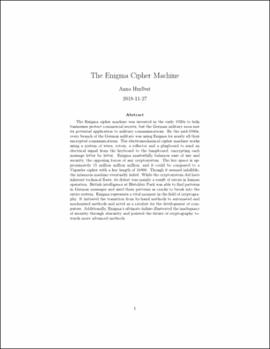| dc.description.abstract | The Enigma cipher machine was invented in the early 1920s to help businesses protect commercial secrets, but the German military soon saw its potential application to military communications. By the mid-1930s, every branch of the German military was using Enigma for nearly all their encrypted communications. The electromechanical cipher machine works using a system of wires, rotors, a reflector, and a plugboard to send an electrical signal from the keyboard to the lampboard, encrypting each message letter by letter. Enigma masterfully balances ease of use and security, the opposing forces of any cryptosystem. The key space is approximately 15 million million million, and it could be compared to a Vigenere cipher with a key length of 16900. Though it seemed infallible, the infamous machine eventually failed. While the cryptosystem did have inherent technical flaws, its defeat was mainly a result of errors in human operation. British intelligence at Bletchley Park was able to find patterns in German messages and used these patterns as cracks to break into the entire system. Enigma represents a vital moment in the field of cryptography. It initiated the transition from by-hand methods to automated and mechanized methods and acted as a catalyst for the development of computers. Additionally, Enigma's ultimate failure illustrated the inadequacy of security through obscurity and pointed the future of cryptography towards more advanced methods. | |
